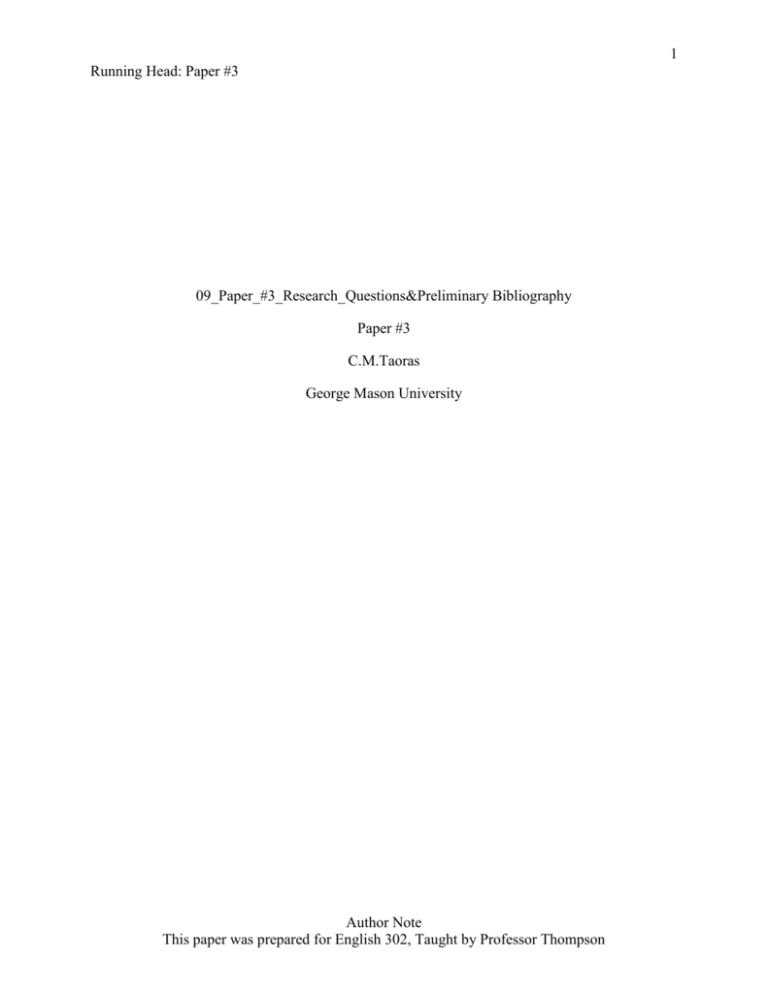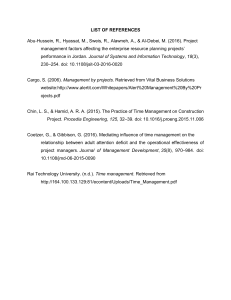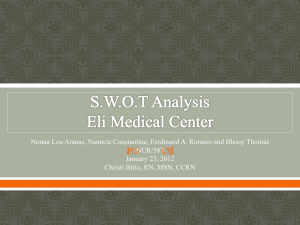09-Paper #3_CaraT
advertisement

1 Running Head: Paper #3 09_Paper_#3_Research_Questions&Preliminary Bibliography Paper #3 C.M.Taoras George Mason University Author Note This paper was prepared for English 302, Taught by Professor Thompson 2 Paper #3 1. How does systems theory and information systems work together to modernize current business practices? 2. How does innovation in technology change organizational behavior? 3. How has Organizational Agility and technology effected the customer experience? 3 Paper #3 References Bateman, T.S., Snell, S.A. (2013). Management. New York, NY: McGraw-Hill/Irwin. Management is a required George Mason University textbook currently used in MSOM courses. Thomas Bateman is a professor at the McIntire School of Commerce of the University of Virginia. He has written several educational books on the topic of management from an overview perspective. He specializes in organizational behavior and other aspects of management. Dr. Scott S. Snell is a leadership professor for the Darden Graduate School of Business at the University of Virginia. He teaches on the subject of management and various aspects associated with management practices. Collins, J. (2001). Good to great: Why some companies make the leap and others don’t. New York, NY: HarperCollings Publishers Inc. Some information retrieved 2015,from www.jimcolliins.com Jim Collins is a former faculty member for the Stanford Graduate School of Business. He has published numerous ground breaking studies and books on the subject of management. His studies include research into successful leadership traits and company successes and failures. Forza, C. (1995). Quality information systems and quality management: a reference model and associated measures for empirical research. Industrial Management & Data Systems, (Vol. 95 Iss: 2, pp.6 – 14). Retrieved June 2015 from http://dx.doi.org/10.1108/02635579510082502 Cipriano Forza is a faculty member at the institute of Ingegnera Gestional located in Vicenza, Italy where he works under the Department of Technology and Management 4 Paper #3 of Industrial Systems (DTG) department. He lectures on Economics and Business(Economia E Organizzazione Aziendale), and Product Variety Management. Gibson, M. (2011, August 9). The 25 most influential business management books. Retrieved 2015, from http://content.time.com/time/specials/packages/completelist/0,29569,2086680,00.html Time Magazine began its illustrious career of brining the world to our homes in 1923. Time is one of the most highly circulated magazines in the world. Haynes, T. (2007). Management/Leadership styles. Encyclopedia of Business and Finance(2nd ed). Retrieved 2015 from http://www.encyclopedia.com/topic/Management.aspx#2 This publication is written more toward non-professionals and individuals new to this industry. This is an ideal source to use when you are trying to pull together several different subjects. I would consider this site incredibly useful in BIS degree planning and preparation. Information technology service management: ITSM. (2015). Axelos global best practice: Making organizations more effective. Retrieved 2015, from https://www.axelos.com/ ITSM is a professional organization requiring certification training and completion. ITSM recommends best practices and strategies for management success. Karake, Z.A. (1994). A Study of Information Technology Structure: Firm Ownership and Managerial Characteristics. Information Management & Computer Security. (Vol. 2 Iss: 5, pp.21 – 30). Retrieved June 2015 from http://dx.doi.org/10.1108/09685229410072591 Dr. Karake has been a University professor most of her adult life. She is adapt at effectively teaching business practices and procedures through her work. She has written several academic books and articles throughout her career. 5 Paper #3 Project management certification program: PMP. (2015). Project management institute. Retrieved 2015, from http://www.ocpe.gmu.edu/programs/proj_mgmt/proj_mgmt_cert.html The PMP certification is a highly recommended and often times requirement for senior leadership positions. In theory, teaches more efficient and effective means of project success and goal attainment. Rungi,M. (2010). Success rate and resource consumption from project interdependencies. Industrial Management & Data Systems, (Vol. 110 Iss 1 pp. 93 - 110). Retrieved June 2015 from http://dx.doi.org/10.1108/02635571011008425 Mait Rungi is an Associate professor for the Tallinn School of Economics and Business Administration for Tallinn University of Technology in Tallinn, Estonia Skrinjar, R., Trkman, P., (2012). Increasing process orientation with business process management: Critical practices’. International Journal of Information Management, 33(2013), 48-60. Retrieved 2015 from http://dx.doi.org/10.1016/j.ijinfomgt.2012.05.011 Skrinjar and Trkman are faculty members at the University of Ljubljana in Slovenia. They work in the field of Economics, but have different specialties. Skrinjar is adapt at business process design management, and consults for businesses on the side. Trkman specializes on the Information Technology part of business management and operations and has published numerous articles, papers, and other peer reviewed items.








